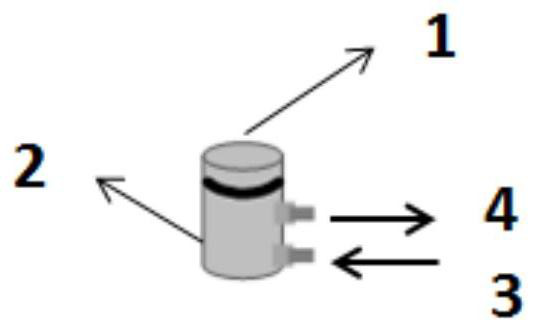Dopant cartridge and method for stably controlling concentration of ion mobility spectrometry chemical dopant
An ion mobility spectrometry and chemical doping technology is applied in the field of dopant cartridges for stably controlling the concentration of chemical dopants in a positive ion high pressure mode, which can solve the problems of large consumption of acetone, troublesome on-site application of experimental operators, etc. Effects of ionization, signal enhancement, extended life cycle
- Summary
- Abstract
- Description
- Claims
- Application Information
AI Technical Summary
Problems solved by technology
Method used
Image
Examples
Embodiment 1
[0031] Connect the apparatus according to the above-mentioned embodiment, the inner diameter of the tetrafluoro hollow tube on the upper cover of the reagent bottle in the dopant cylinder is an inner diameter of 250 μm, and a length of 1 cm, and the doping reagent of acetone and carbon tetrachloride is housed in the doping reagent bottle, wherein 0.2 Mix 1 ml carbon tetrachloride and 2 ml acetone, and the steam diffuses from the tetrafluoro hollow tube to the outside of the doping reagent bottle and the dopant cylinder. Use the combination of acetone and carbon tetrachloride as the doping reagent to ionize to generate reagent ions. When the doping reagent generally reaches 1000mv according to the daily required RIP signal strength, use 2ml of acetone and 0.2ml of carbon tetrachloride as the doping reagent. Acetone basically If it is used up for more than ten days, the combined dopant reagent ion peak is as follows image 3 mentioned.
[0032] Can find out by the result of com...
Embodiment 2
[0034] In the prior art, sensors are used to identify the liquid level control of reagents. Since the composition of the doping reagent is usually an organic phase, and the bottle of the doping reagent is relatively small, it is not suitable for adding a sensor warning light node for the doping reagent. Current photoionization ion mobility spectrometry uses dopant reagent-depleted nodes, often by doping reagents with light-free reagent ion peak identification. This method uses a combination of acetone and carbon tetrachloride as a doping reagent. When the concentration of acetone is very low, there will be peak tailing, which can be identified by the half-peak width of the ion mobility spectrum. Such as image 3 , under the same conditions, the normal spectral peak width at half maximum is 0.24~0.32ms; if Figure 4 As stated, the half-peak width is 0.48ms, which is already greater than 0.4ms, which means that the acetone is about to be exhausted (there is still a surplus), a...
PUM
| Property | Measurement | Unit |
|---|---|---|
| diameter | aaaaa | aaaaa |
| boiling point | aaaaa | aaaaa |
| freezing point | aaaaa | aaaaa |
Abstract
Description
Claims
Application Information
 Login to View More
Login to View More - R&D
- Intellectual Property
- Life Sciences
- Materials
- Tech Scout
- Unparalleled Data Quality
- Higher Quality Content
- 60% Fewer Hallucinations
Browse by: Latest US Patents, China's latest patents, Technical Efficacy Thesaurus, Application Domain, Technology Topic, Popular Technical Reports.
© 2025 PatSnap. All rights reserved.Legal|Privacy policy|Modern Slavery Act Transparency Statement|Sitemap|About US| Contact US: help@patsnap.com



